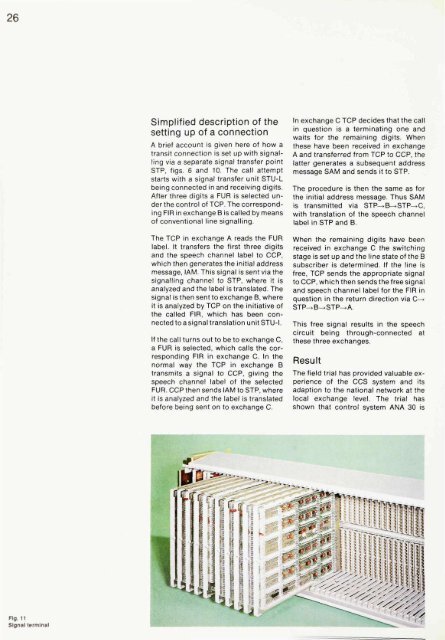ericsson review - ericssonhistory.com
ericsson review - ericssonhistory.com
ericsson review - ericssonhistory.com
Create successful ePaper yourself
Turn your PDF publications into a flip-book with our unique Google optimized e-Paper software.
26<br />
Simplified description of the<br />
setting up of a connection<br />
A brief account is given here of how a<br />
transit connection is set up with signalling<br />
via a separate signal transfer point<br />
STP, figs. 6 and 10. The call attempt<br />
starts with a signal transfer unit STU-L<br />
being connected in and receiving digits.<br />
After three digits a FUR is selected under<br />
the control of TCP. The corresponding<br />
FIR in exchange B is called by means<br />
of conventional line signalling.<br />
The TCP in exchange A reads the FUR<br />
label. It transfers the first three digits<br />
and the speech channel label to CCP,<br />
which then generates the initial address<br />
message, IAM. This signal is sent via the<br />
signalling channel to STP, where it is<br />
analyzed and the label is translated. The<br />
signal is then sent to exchange B, where<br />
it is analyzed by TCP on the initiative of<br />
the called FIR, which has been connected<br />
to a signal translation unit STU-I.<br />
If the call turns out to be to exchange C,<br />
a FUR is selected, which calls the corresponding<br />
FIR in exchange C. In the<br />
normal way the TCP in exchange B<br />
transmits a signal to CCP, giving the<br />
speech channel label of the selected<br />
FUR. CCP then sends IAM to STP, where<br />
it is analyzed and the label is translated<br />
before being sent on to exchange C.<br />
In exchange C TCP decides that the call<br />
in question is a terminating one and<br />
waits for the remaining digits. When<br />
these have been received in exchange<br />
A and transferred from TCP to CCP, the<br />
latter generates a subsequent address<br />
message SAM and sends it to STP.<br />
The procedure is then the same as for<br />
the initial address message. Thus SAM<br />
is transmitted via STP-^B->STP-^C,<br />
with translation of the speech channel<br />
label in STP and B.<br />
When the remaining digits have been<br />
received in exchange C the switching<br />
stage is set up and the line state of the B<br />
subscriber is determined. If the line is<br />
free, TCP sends the appropriate signal<br />
to CCP, which then sends the free signal<br />
and speech channel label for the FIR in<br />
question in the return direction via C-*<br />
STP-^B^STP-^A.<br />
This free signal results in the speech<br />
circuit being through-connected at<br />
these three exchanges.<br />
Result<br />
The field trial has provided valuable experience<br />
of the CCS system and its<br />
adaption to the national network at the<br />
local exchange level. The trial has<br />
shown that control system ANA 30 is<br />
Fig. 11<br />
Signal terminal
















